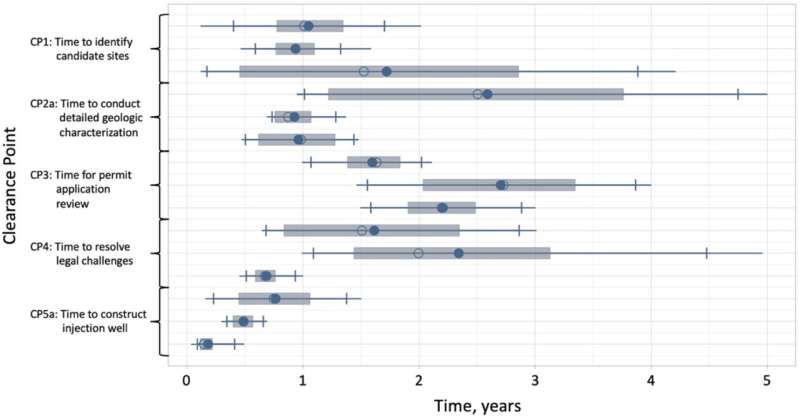This article has been reviewed according to Science X's editorial process and policies. Editors have highlighted the following attributes while ensuring the content's credibility:
fact-checked
peer-reviewed publication
trusted source
proofread
New study aims to reduce the time required to implement geologic sequestration sites for carbon capture

Carbon capture and sequestration (CCS), the process of capturing and storing atmospheric carbon dioxide, is one method of reducing the amount of carbon dioxide in the atmosphere in efforts to reduce the impacts of climate change. While CCS is an essential tool in decarbonizing the U.S. economy, there are barriers that exist to the development, approval, and implementation of a geologic sequestration site, as it requires an appropriate geologic formation, as well as an approved injection facility.
Recent work from the Carnegie Mellon University Department of Engineering and Public Policy (EPP) estimates the time required to develop, approve, and implement a geologic sequestration site in the U.S. by identifying six clearance points that must be passed for a site to become operational and provides insights into how this timeframe could be reduced.
The clearance points identified include time to find site(s), time to prepare the selected site, time for EPA approval, time to resolve any legal challenge, time to construct the well and pipeline, and time for injection authorization. By seeking input from experts on each clearance point, Ph.D. student Emily Moore and faculty members Valerie Karplus and Granger Morgan combined expert judgments in a simulation framework to project timeframes within which these points could be cleared.
"Understanding the many steps and expected timeframes is an essential starting point to assess what needs to happen if society wants to deploy carbon capture and sequestration as a decarbonization solution," says Karplus. "It is unlikely that timing written into regulatory processes for key steps will be realized in practice, so we turned to experts for their views."
The findings, now published in the Proceedings of the National Academy of Sciences, indicate that on average, there is a 90% probability that the time required for a site to become operational is between 5.5 and 9.6 years, with an upper bound of 12 years. Even using the most optimistic expert judgments, the lower bound is 2.7 years, and the upper bound is 8.3 years.
These estimates show that strategies must be implemented to accelerate the process if CCS is to have a meaningful impact toward the nation's 2050 climate goals. This is particularly critical if projects are to be eligible for the Section 45Q CCS tax credit under the Inflation Reduction Act, which expires in 2032, well before the upper bound estimate of 12 years. The authors put forth seven recommendations that could speed the time for sites to be utilized.
The clearance points that were estimated to cause the longest non-technical delays included pore space acquisition, the Class VI permit application review process, and potential litigation, and as such the recommendations address these obstacles.
Currently only North Dakota and Wyoming have Class VI primacy, which allows these states to expedite their application process. By granting states primacy, there is potential to speed up the permitting process, and legislative efforts could be feasible to facilitate these endeavors. Additionally, legal frameworks could be developed to reduce litigation and proactively engage communities where sites are being developed.
"Prior work has suggested that public acceptance is essential for emerging technologies to reach wider application," said Moore. "Our research suggests that court challenges could extend time frames substantially. Engaging the public, along with treating landowners as important stakeholders, could go a long way toward mitigating the risk of protracted delays."
Over a decade ago, recognizing that the U.S. would soon need CCS to decarbonize the nation's energy system, Morgan and colleagues at Carnegie Mellon led a team of technical and legal experts that developed a comprehensive approach that addressed key issues, including ownership of the deep subsurface, learning from experience, and long-term stewardship and liability. The project's recommendations and resulting book were widely distributed to members of Congress and other key decision makers.
Reflecting on this earlier work, Morgan observes, "Back then, decarbonizing the energy system was not on the top of most policy agendas, so we have ended up with a piecemeal system that addresses only a part of the problem on a state-by-state basis. While that's better than nothing, we need to accelerate the process and make sure that issues such as liability and long-term stewardship are appropriately addressed."
More information: Emily J. Moore et al, Expert elicitation of the timing and uncertainty to establish a geologic sequestration well for CO 2 in the United States, Proceedings of the National Academy of Sciences (2023). DOI: 10.1073/pnas.2307984120
Journal information: Proceedings of the National Academy of Sciences
Provided by Carnegie Mellon University




















